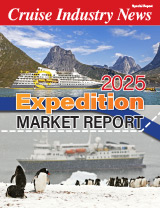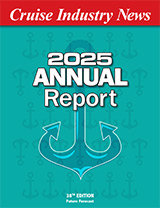MedCruises’ general assembly was held in Alanya, Turkey, Nov. 13 – 16 with member ports, tour operators and boards of tourism, in addition to participating cruise lines, including Azamara, Disney, Holland America, Princess, Royal Caribbean, TUI and Windstar.
MedCruise presented the findings of a just-completed study of financing options and models for cruise ports and terminals. Just completed, different models included public and private financing alternatives, as well as various levels of joint ventures with cruise lines. As ships are getting larger and carrying more passengers, more ports will need to expand their facilities and hence search for financing.
So far, the trend in the Mediterranean has been for privatization of cruise terminals. Today, 41 percent are publicly owned, 31 percent are private and 27 percent have private-public ownership.
Among the conclusions offered, investments in infrastructure are necessary for cruise development and that new facilities should be built at a cost level acceptable to cruise lines.
Commenting on the study, Claudius Docekal, manager of deployment for Azamara, said investments in ports and infrastructure will not by itself attract ships, noting that location, location and location determine fuel-driven itineraries. His advice was that any facility should be built inexpensively and be multifunctional.
Russell Daya, director of global port operations and development for Disney, said he finds it problematic when cruise companies invest and get preferential berthing rights. Unless berthing policies are fair and transparent, they can preclude Disney from calling, he said.
Rob Roberts, manager of shore excursions for Princess, noted how it was important to coordinate port operations with passenger logistics and shore excursions. The cruise line’s criteria for itineraries are based on destinations will sell, generate revenue and deliver well in addition to operational considerations, and ultimately a cost/benefit analysis.
Justin Poulson, senior manager of deployment and itinerary planning for Holland America Line, said that for 2014 the cruise line is reducing its capacity in the Eastern Mediterranean because of travel warnings for Egypt and the escalating conflict in Syria, with its spillover into Turkey, which, he said has resulted in soft ticket yields and stalled future bookings. He added that revenue and net margins were much higher for the Western Mediterranean, with the highest margins generated by cruises out of Venice.
Poulson also pointed out how Holland America has reduced the sailing speeds of its ships from an average 17.6 knots in 2011 to 15.6 knots in 2015. This is in turn reducing itinerary distances, leading to new turnaround ports, new ports of call and shorter time in port.
For 2015, the core of Holland America’s summer deployment will be in Alaska and the Western Mediterranean. The line is also going back to Bermuda, but will reduce its Canada/New England sailings.
In terms of port ratings, Poulson said that Istanbul was the only port on the line’s list of its top 100 most popular and most profitable ports.
Thomas Rucht, manager of port operations for TUI Cruises, said that berth reservations and confirmation were an issue, and that the brand was now requesting berths for 2015. In reality, however, while ports agree to berths, they often only confirm one week in advance. New ports for TUI in 2014 include Brindisi and Bodrum. In 2015, TUI will expand to the Black Sea.
Miguel Reyna, director of port business development and asset management for Royal Caribbean listed what he saw as positives for the Mediterranean as customer interest and sourcing, and the negatives as the restriction on big ships in Venice, port congestion, what he called the Arab Winter, perceived security concerns in Turkey, and local vested interests that want to keep the status quo instead of developing cruise facilities.
Reyna noted that it may take five years to get dredging permits in Italy, and the delayed new port in Istanbul. He described the existing piers in Istanbul are obsolete and inadequate.
Sander Groothuis, director of marine operations for Windstar Cruises, said his company will expand its Mediterranean deployment with the addition of its three-ship acquisition from Seabourn. Of the three sail-assisted vessels, however, one will be redeployed to Tahiti.
Windstar’s port needs are different from the other brands with larger vessels and Groothuis listed his requirements to be access to smaller ports, spending more time in port, and a more intimate shore experience with a deeper cultural engagement and away from crowds.
The issues Groothuis runs into includes the recent ban on smaller vessels anchoring close to shore (following the Concordia incident), being taxed on longer stays in port and terminals that are not suitable for smaller, upscale ships. He also said he preferred the older port in Istanbul, which he described as genuine, instead of being a theme park.
Mark Robinson, managing director of Intercruises, noted his company’s efforts to host workshops for local stakeholders so that all ground handlers become engaged in serving the ships, the passengers and the crew.
As for the trend of lower shore excursion revenues reported by cruise lines, Robinson said that lines must look at their pricing policies and distribution channels. Meanwhile, independent shore excursion operators are gaining a bigger foothold.
Erkunt Oner, president and CEO of TURA Tourizm, made a case for Eastern Mediterranean itineraries being year-round, for Turkish ports, with turnaround opportunities in Istanbul, Izmir, Antalya and Alanya. He also said that Istanbul was the ideal starting point for a program of butterfly itineraries, alternating into the Black Sea and the Eastern Mediterranean.
Turkey also has the potential as a source market, according to Oner, who said Turkey is the 16th largest economy in the world and 6th largest in Europe, with a population of 74 million.
Hosting the conference, Captain Haluk Sayman, marketing director of the Alanya Cruise port, opened the conference with MedCruise President Stavros Hatzakos.
According to Sayman, Alanya will have 53 cruise calls in 2013 and 56,000 passengers, a 50 percent increase over 2012. Altogether, Alanya had 2.5 million visitors in 2012 representing 8 percent of all tourist traffic to Turkey. The resident population is 100,000, including 15,000 Europeans. With a number of sites (to be reported on separately), a new marina was recently completed, and plans call for a ski resort to be developed on nearby mountains.
The financial study was done by Hugues Lamy of Cruise Management Consulting, who presented its findings. A roundtable discussing market prospects was moderated by David Selby of Travelyields Consulting.
A full report on MedCruise and Alanya will run in the winter issue of Cruise Industry News.



